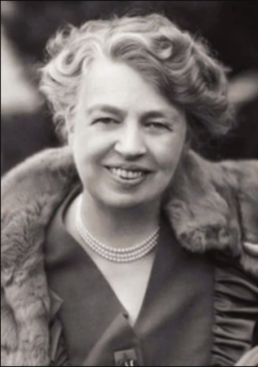These life stories may contain descriptions of childhood trauma and abuse, as well as images, voices and names of people now deceased. If you need help, you can find contact details for some relevant support services on our support page.
Former First Lady of the United States, Eleanor Roosevelt (1884-1962), was in kinship care as a child.
Anna Eleanor Roosevelt was born into privilege. She was a member of a prominent American family and niece of President Theodore Roosevelt (1858-1919).
Eleanor’s mother, who chastised the child because she thought her ugly, died when Eleanor was eight years old. Eleanor’s father, Teddy Roosevelt’s brother, was already banished from the home because of his alcoholism and allowed only occasional visits with his daughter. He died when Eleanor was ten.
Until she was fifteen, Eleanor was raised by her “maternal grandfather [who is described as “rigid, conservative, unloving”] and alcoholic uncles”.
If there were the comforts of affluence, it would not be an exaggeration to say that her life was emotionally impoverished. (Beck, 532)
Becoming concerned about the teenager living in the same house with her alcoholic uncles, Eleanor’s grandmother sent her to a boarding school in England. Allenwood was a private school run by a French woman, Mlle. Souvestre. Souvestre was encouraging of Eleanor, bolstered her self-confidence, and suggested new ideas to her. Not only did Souvestre take an interest in Eleanor at school, but she also took the girl on a tour of Europe.
When Eleanor was summonsed to return home by her grandmother, she took up social causes, as was expected of a woman of her class. This was important training for her future career as First Lady and woman in public life as she was exposed to “the defeatism of poverty, the problems of the slums, and the exploitation of works” (Burke, 366).
Eleanor married Franklin Delano Roosevelt, her cousin, in 1905. For twelve years she concentrated on her role as wife and mother to five children, after which she increasingly assume a role in public life. When her husband became ill with polio, she took up appointments that helped to ensure his political future as President of the United States.
From a shy, fearful child, Eleanor Roosevelt grew to become an independent, powerful advocate of social change; the articulate, compassionate leader who spoke and acted on behalf of the poor, sharecroppers, out-of-work youth, coalminers, women, Appalachian farmers, and European refugees. (Burke, 369).
As First Lady from 1933 to 1945, Eleanor Roosevelt’s power increased and she was influential in securing appointments for women and looked after the interests of working women adversely affected by the Great Depression.
Forget First Lady, Eleanor Roosevelt was one of the master politicians of the 20th century, period. F.D.R’s legacy cannot be understood apart from hers. While some First Ladies are remembered for redecorating the White House, Eleanor was the first to hold press conferences (more than 300 of them), to visit – alone – U.S. soldiers at war overseas and to shrewdly manoeuvre her agenda through the back corridors of the White House for twelve years, chipping away at segregation, poverty and injustice. She may be the only First Lady ever to have had a Ku Klux Klan bounty on her head (Ripley).
After her husband died in 1945, Eleanor Roosevelt continued in public life. She was appointed to the United Nations by President Truman and she was influential in drafting the Universal Declaration of Human Rights.
Eleanor Roosevelt was a prolific writer, writing about civil rights in the 1930s and publishing twenty-eight books from 1932.
References:
Beck, Susan Abrams. “Eleanor Roosevelt: The Path to Equality.” White House Studies, vol. 4, no.4 (2004):531-544.
Burke, Fran. “Eleanor Roosevelt, October 11, 1884-November 7, 1962 – She Made a Difference.” Public Administration Review, vol.44, no.5 (1984):365-372.
Ripley, Amanda. “The Relentless Mrs. Roosevelt.” Time, vol. 173, no.26 (2009)
Image available here.
